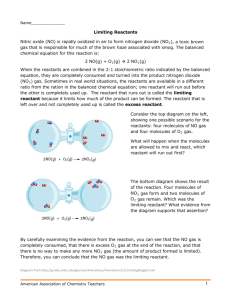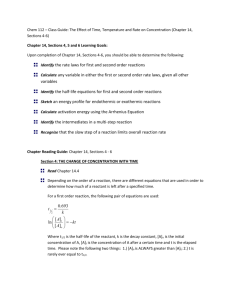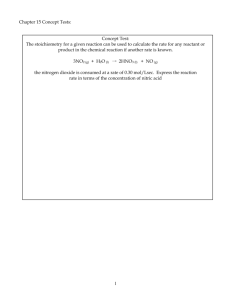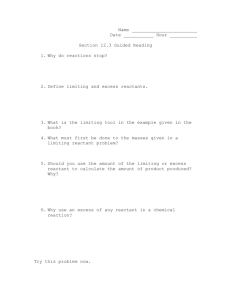AP Chemistry--Chapter 12: Chemical Kinetics
advertisement
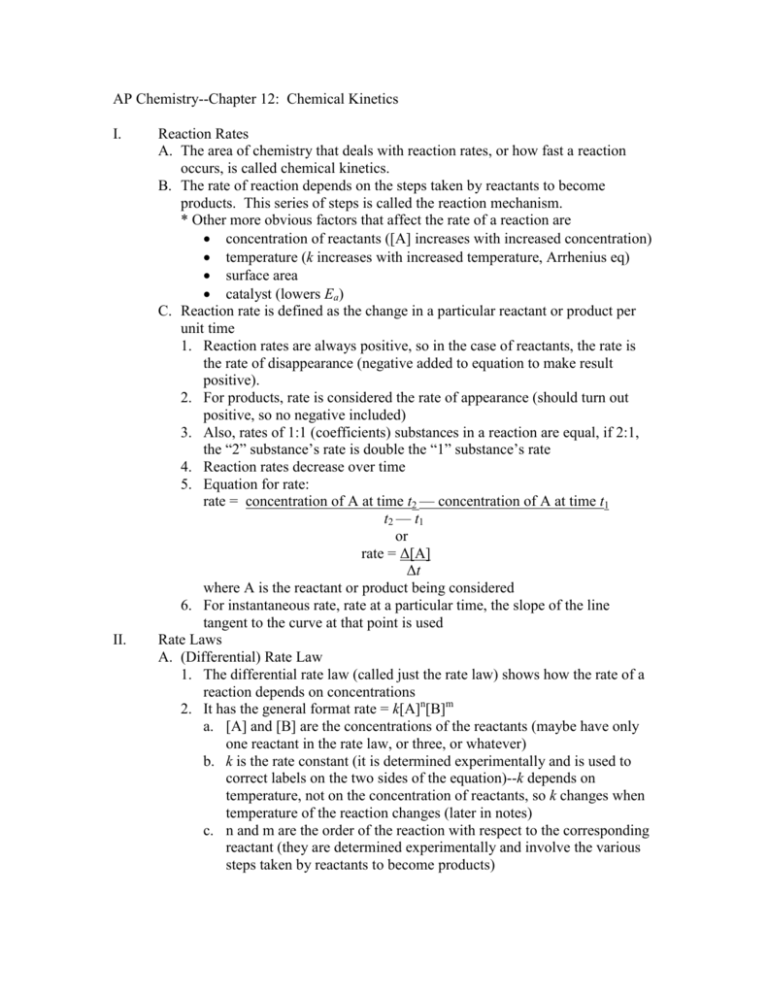
AP Chemistry--Chapter 12: Chemical Kinetics I. II. Reaction Rates A. The area of chemistry that deals with reaction rates, or how fast a reaction occurs, is called chemical kinetics. B. The rate of reaction depends on the steps taken by reactants to become products. This series of steps is called the reaction mechanism. * Other more obvious factors that affect the rate of a reaction are concentration of reactants ([A] increases with increased concentration) temperature (k increases with increased temperature, Arrhenius eq) surface area catalyst (lowers Ea) C. Reaction rate is defined as the change in a particular reactant or product per unit time 1. Reaction rates are always positive, so in the case of reactants, the rate is the rate of disappearance (negative added to equation to make result positive). 2. For products, rate is considered the rate of appearance (should turn out positive, so no negative included) 3. Also, rates of 1:1 (coefficients) substances in a reaction are equal, if 2:1, the “2” substance’s rate is double the “1” substance’s rate 4. Reaction rates decrease over time 5. Equation for rate: rate = concentration of A at time t2 — concentration of A at time t1 t2 — t1 or rate = Δ[A] Δt where A is the reactant or product being considered 6. For instantaneous rate, rate at a particular time, the slope of the line tangent to the curve at that point is used Rate Laws A. (Differential) Rate Law 1. The differential rate law (called just the rate law) shows how the rate of a reaction depends on concentrations 2. It has the general format rate = k[A]n[B]m a. [A] and [B] are the concentrations of the reactants (maybe have only one reactant in the rate law, or three, or whatever) b. k is the rate constant (it is determined experimentally and is used to correct labels on the two sides of the equation)--k depends on temperature, not on the concentration of reactants, so k changes when temperature of the reaction changes (later in notes) c. n and m are the order of the reaction with respect to the corresponding reactant (they are determined experimentally and involve the various steps taken by reactants to become products) B. Integrated Rate Law shows how the concentration of species in the reaction depends on time (various equations will be presented later) C. Knowing the rate law for a reaction is important mainly because we can usually infer the individual steps involved in the reaction from the specific form of the rate law. III. Determining the Form of the Rate Law A. Determining the form of the rate law means to basically determine the order of the reaction (recall rate = k[A]n[B]m) B. The overall order of a reaction is the sum of n + m + (if any more) 1. n and m are NOT COEFFICIENTS, they are experimentally determined from data and in the rate law become exponents 2. n and m are referred to as the order with respect to the particular corresponding reactant 3. n and m can be 1, 2, etc, even 0, ½, –½ a. rate = k[X][Y], 2nd order overall, 1st order WRT X and Y b. rate = k[X]2, 2nd order overall, 2nd order WRT X C. k can also be determined from experimental data 1. once the rate law is determined, plug in concentrations from any experiment to solve for k 2. the units of k for different reactions vary since the overall order of a reaction and the rate law of a reaction also vary; the units of the rate constant need to allow the rate law expression to = M/s (usually shown as mol· L–1· s–1 or mol L–1 s–1) 3. rate order does not change with increasing temperature, k changes IV. The Integrated Rate Law A. First Order Rate Laws (sum of n + m + etc. = 1) 1. Recall integrated rate laws express concentration as a function of time 2. The equation below is for first order reactions (you may also see different forms of it) *Note [ ] = molarity, usually shown as mol· L–1 a. [A]t is the concentration of a particular reactant after time t b. [A]0 is the initial concentration of the reactant c. k is the rate constant d. t is time (“after time t”) y = mx + b form: ln[ A]t kt ln[ A]0 Given on your green sheet as: ln[ A]t ln[ A]0 kt Sketch of graph of 1st order reaction: What would you need plot to get a straight line? What would this graph look like? What would the slope of this line equal? B. Second Order Rate Laws (sum of n + m + etc. = 2) 1 1 y = mx + b form: kt [ A]t [ A]0 1 1 on your green sheets: kt [ A]t [ A]0 Sketch of graph of 2nd order reaction: What would you need plot to get a straight line? What would this graph look like? What would the slope of this line equal? C. Zero Order Rate Laws (sum of n + m + etc. = 0) and half-life 1. zero order reactions occur when the rate of the reaction is constant, no matter if initial concentrations are changed or not 2. an example of a zero order reaction would be the decomposition of a substance when it comes in contact with a surface; only those at the surface can react so more wouldn’t matter 3. zero-order rate law: rate = k Sketch of graph of zero order reaction: V. D. The integrated rate laws for reactions beyond second order are found by setting certain conditions in the reaction 1. for example, one reactant has a large concentration compared to the other in the reaction and information concerning order with respect to that reactant are found 2. the reaction, when simplified by this criteria may reduce to first order, for example Reaction Mechanisms A. The process by which a reaction occurs is called the reaction mechanism. A reaction mechanism can describe how bonds are broken and formed and the way in which the atoms move during a reaction. B. If a reaction occurs in one single event or step, it is called an elementary step. For instance, when NO combines with O3 to form NO2 and O2 (one oxygen moves from O3 to NO). C. The number of molecules that participate in a reaction is referred to as the molecularity of the step. 1. If a single molecule is involved, the reaction is said to be unimolecular. 2. If two reactant molecules collide during the reaction, the reaction is bimolecular. 3. Three molecules is called termolecular, these are rare (why?) D. A multistep mechanism involves a molecule that is neither a reactant nor a product in the overall reaction, but is produced and consumed during the reaction. Example: NO2 + NO2 NO3 + NO + NO3 + CO NO2 + CO2 _______________________________ NO2 + CO NO + CO2 During this reaction, NO3 is produced and consumed before the final products are formed. The NO3, therefore, is called an intermediate. E. Catalysts can also be identified in a reaction mechanism. They are a reactant in the beginning, a product at the end, and do not appear in the final reaction. Example: Step 1: Ce4+ + Mn2+ Ce3+ + Mn3+ Step 2: Ce4+ + Mn3+ Ce3+ + Mn4+ Step 3: Mn4+ + Tl+ Tl3+ + Mn2+ What is the catalyst above? Is there an intermediate? What is the overall reaction? F. Further definition of reaction mechanism--it is a series of elementary steps that must satisfy two requirements: 1. The Stoichiometry: the sum of the elementary steps must give the overall balanced equation for the reaction 2. The Rate Law: the mechanism must agree with the experimentally determined rate law (this where the rate-determining step can be determined) VI. A Model for Chemical Kinetics A. The collision model 1. molecules must collide to react 2. at higher temperatures, molecules are colliding more often and at higher speeds, and it is shown that nearly all reactions occur faster at higher temperatures a. fast reactions have low activation energy and weaker reactant bonds b. slow reactions have high activation energy and stronger reactant bonds B. Since temperature does not affect concentration very much, the rate constant in a rate law must change with increasing temperature. C. The Arrhenius equation allows you to calculate the rate constant, k, at some different temperature when the activation energy and rate constant are known at another temperature. 1. the activation energy (Ea) is the minimum energy a reaction must overcome to proceed; it is the energy required to form the transition state in a chemical reaction 2. it is lowered when a catalyst is used a. spark from a spark plug provides energy for combustion reaction b. enzyme catalase to quickly break down H2O2 3. it arises from the energy needed to break bonds, rearrange molecules, etc. Arrhenius Equation (as given on your green sheet) E 1 ln k a ln A where R = 8.31 J mol−1K−1, T is temp in K R T Note here that the above is already in the y = mx+b form; E 1 a graph of ln k vs gives a straight line with slope = a R T Sample graph to find Ea What would this graph look like? 4. So, you can also use the Arrhenius Equation to find activation energy by measuring the rate of a reaction at various temperatures

